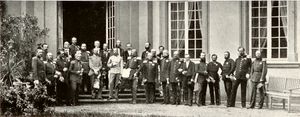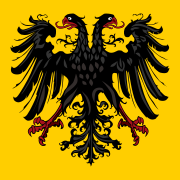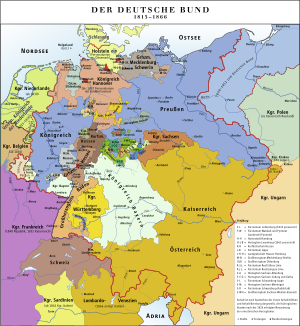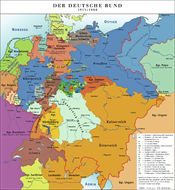الاتحاد الألماني
الاتحاد الألماني Deutscher Bund | |
|---|---|
| |
Coat of arms (1848–66)
| |
 The German Confederation in 1815
| |
| المكانة | كونفدرالية |
| العاصمة | Frankfurt |
| اللغات الشائعة |
|
| الدين | Roman Catholic, Protestant |
| Head of the Präsidialmacht Austria | |
• 1815–1835 | Francis I |
• 1835–1848 | Ferdinand I |
• 1850–1866 | Franz Joseph I |
| التشريع | Federal Convention |
| التاريخ | |
| 8 June 1815 | |
| 13 March 1848 | |
| 29 November 1850 | |
| 14 June 1866 | |
| 23 August 1866 | |
| Area | |
| 1815 | 630,100 km2 (243,300 sq mi) |
| التعداد | |
• 1815 | 29200000 |
| Currency |
|
| Today part of | |
الاتحاد الألماني (ألمانية: Deutscher Bund؛ إنگليزية: German Confederation) كان ارتباطاً لـ 39 دولة ناطقة بالألمانية في وسط أوروپا، خـُلـِق في مؤتمر ڤيينا في 1815 لتنسيق اقتصادات البلدان المنفصلة الناطقة بالألمانية وأن يحل محل الامبراطورية الرومانية المقدسة، التي انحلت في 1806.[1]
The Confederation was weakened by rivalry between the Kingdom of Prussia and the Austrian Empire, revolution, and the inability of the multiple members to compromise. In 1848, revolutions by liberals and nationalists attempted to establish a unified German state with a progressive liberal constitution under the Frankfurt Convention. The ruling body, the Confederate Diet, was dissolved on 12 July 1848, but was re-established in 1850 after failed efforts to replace it.[2]
The Confederation was finally dissolved after the Prussian victory in the Seven Weeks' War over Austria in 1866. The dispute over which had the inherent right to rule German lands ended in favour of Prussia, leading to the creation of the North German Confederation under Prussian leadership in 1867. A number of South German states remained independent until they joined the North German Confederation, which was renamed and proclaimed as the "German Empire" in 1871 for the now unified Germany with the Prussian king as emperor (Kaiser) after the victory over French Emperor Napoleon III in the Franco-Prussian War of 1870.
Most historians have judged the Confederation to have been weak and ineffective, as well as an obstacle to the creation of a German nation-state.[3] However, the Confederation was designed to be weak, as it served the interests of the European Great Powers, especially member states Austria and Prussia.
التاريخ
التأسيس
The Confederation was formally created by a second treaty, the Final Act of the Ministerial Conference to Complete and Consolidate the Organization of the German Confederation. This treaty was not concluded and signed by the parties until 15 May 1820. States joined the German Confederation by becoming parties to the second treaty. The states designated for inclusion in the Confederation were:
- Anhalt-Bernburg (inherited by the Duke of Anhalt-Dessau, 1863)
- Anhalt-Dessau
- Anhalt-Köthen (inherited by the Duke of Anhalt-Dessau, 1847/53)
- Austrian Empire (including Crown of Bohemia – Bohemia, Moravia and Austrian Silesia – and Austrian lands – Austria, Carinthia, Carniola, the Littoral, Salzburg, Styria, Tyrol, and Vorarlberg)
- Baden
- Bavaria
- Brunswick
- Hanover
- Electorate of Hesse (also known as Hesse-Kassel)
- Grand Duchy of Hesse (also known as Hesse-Darmstadt)
- Hohenzollern-Hechingen (became part of Prussia in 1850)
- Hohenzollern-Sigmaringen (became part of Prussia in 1850)
- Holstein and Lauenburg, held by Denmark
- Holstein-Oldenburg
- Liechtenstein
- Lippe-Detmold
- Luxembourg, held by the Netherlands
- Mecklenburg-Schwerin
- Mecklenburg-Strelitz
- Nassau
- Prussia
- Reuss, elder line
- Reuss, younger line
- Saxony
- Saxe-Weimar-Eisenach
- Saxe-Coburg (ruler became Duke of Saxe-Coburg and Gotha 1826)
- Saxe-Gotha (partitioned 1826)
- Saxe-Hildburghausen (ruler became Duke of Saxe-Altenburg, 1826)
- Saxe-Meiningen
- Schaumburg-Lippe
- Schwarzburg-Rudolstadt
- Schwarzburg-Sondershausen
- Waldeck
- Württemberg
- Hesse-Homburg (inherited by the grand-duke of Hesse-Darmstadt, 1866) (joined by treaty in 1820)
- Lübeck (joined by treaty in 1820)
- Frankfurt (joined by treaty in 1820)
- Bremen (joined by treaty in 1820)
- Hamburg (joined by treaty in 1820)
In 1839, as compensation for the loss of the province of Luxemburg to Belgium, the Duchy of Limburg (held by the Netherlands) was created and it was a member of the German Confederation until its dissolution in 1866. The cities of Maastricht and Venlo were not included in the Confederation.
القوات المسلحة
| State | Area [km²] | Population[A 1] | Matriculation class[A 2] (proportion of total) |
Annual expenditures (in Austrian Gulden)[A 3] |
Army Corps | Troop Totals[A 4] |
|---|---|---|---|---|---|---|
| الامبراطورية النمساوية[A 5] | [A 6]197,573 | [A 6]10,086,900 | 31.44% | 9,432,000 | I, II, III | 158,037 |
| مملكة پروسيا[A 7] | [A 6]185,496 | [A 6]9,957,000 | 26.52% | 7,956,000 | IV, V, VI | 133,769 |
| مملكة باڤاريا | 76,258 | 4,120,000 | 11.8% | 3,540,000 | VII | 59,334 |
| Kingdom of Hannover | 38,452 | 1,549,000 | 4.33% | 1,299,000 | X (1st Div., part) | 21,757 |
| Kingdom of Württemberg | 19,504 | 1,547,400 | 4.63% | 1,389,000 | VIII (1st Div.) | 23,259 |
| Kingdom of Saxony | 14,993 | 1,480,000 | 3.98% | 1,194,000 | IX (1st Div.) | 20,000 |
| Grand Duchy of Baden | 15,269 | 1,175,000 | 3.31% | 993,000 | VIII (2nd Div.) | 16,667 |
| Grand Duchy of Hesse-Darmstadt | 7,680 | 720,000 | 2.05% | 615,000 | VIII (3rd Div., part) | 10,325 |
| Grand Duchy of Mecklenburg-Schwerin | 13,304 | 455,000 | 1.19% | 357,000 | X (2nd Div., part) | 5,967 |
| Grand Duchy of Mecklenburg-Strelitz | 2,929 | 85,000 | 0.24% | 72,000 | X (2nd Div., part) | 1,197 |
| Grand Duchy of Oldenburg | 6,420 | 250,000 | 0.73% | 219,000 | X (2nd Div., part) | 3,740 |
| Grand Duchy of Luxemburg (with the Duchy of Limburg) | 2,586 | 259,500 | 0.40% | 120,000 | IX (2nd Div., part) | 2,706 |
| Grand Duchy of Saxe-Weimar | 3,593 | 233,814 | 0.67% | 201,000 | Reserve (part) | 3,350 |
| Electoral Hesse | 9,581 | 629,000 | 1.88% | 564,000 | IX (2nd Div., part) | 9,466 |
| Duchy of Anhalt-Dessau | 840 | 57,629 | 0.19% | 57,000 | Reserve (part) | 1,422 |
| Duchy of Anhalt-Cöthen[A 8] | 727 | 36,000 | 0.10% | 30,000 | Reserve (part) | 325[A 9] |
| Duchy of Anhalt-Bernburg[A 10] | 780 | 43,325 | 0.12% | 36,000 | Reserve (part) | 616 |
| Duchy of Brunswick | 3,690 | 245,783 | 0.69% | 20,000 | X (1st Div., part) | 3,493 |
| Duchies of Holstein and Saxe-Lauenburg[A 11] | 9,580 | 450,000 | 0.12% | 35,000 | X (2nd Div., part) | 6,000 |
| Duchy of Nassau | 4,700 | 360,000 | 1.00% | 300,000 | IX (2nd Div., part) | 6,109 |
| Duchy of Saxe-Altenburg | 1,287 | 114,048 | 0.33% | 99,000 | Reserve (part) | 1,638 |
| Duchy of Saxe-Coburg-Gotha[A 12] | 2,688 | 156,639 | 0.37% | 111,000 | Reserve (part) | 1,860 |
| Duchy of Saxe-Hildburghausen[A 13] | 0 | 0 | 0% | 0 | Reserve (part) | 0[A 14] |
| Duchy of Saxe-Meiningen | 2,293 | 136,000 | 0.38% | 114,000 | Reserve (part) | 1,918 |
| Principality of Hohenzollern-Sigmaringen | 906 | 42,341 | 1.40% | 420,000 | VIII (3rd Div., part) | 356[A 15] |
| Principality of Hohenzollern-Hechingen | 236 | 17,000 | 0.05% | 15,000 | VIII (3rd Div., part) | 155[A 16] |
| Principality of Lippe-Detmold | 1,133 | 77,500 | 0.23% | 69,000 | Reserve (part) | 1,202 |
| Principality of Schaumburg-Lippe | 536 | 23,128 | 0.07% | 21,000 | Reserve (part) | 350 |
| Principality of Liechtenstein | 159 | 5,800 | 0.02% | 6,000 | Reserve (part) | 91 |
| Principality of Reuß elder line | 316 | 24,500 | 0.07% | 21,000 | Reserve (part) | 1,241 |
| Principality of Reuß younger line | 826 | 59,000 | 0.17% | 51,000 | Reserve (part) | see Reuß elder line |
| Principality of Schwarzburg-Rudolstadt | 940 | 60,000 | 0.18% | 54,000 | Reserve (part) | 899 |
| Principality of Waldeck | 1,121 | 56,000 | 0.17% | 51,000 | Reserve (part) | 866 |
| Principality of Schwarzburg-Sondershausen | 862 | 51,767 | 0.15% | 45,000 | Reserve (part) | 751 |
| Landgraviate of Hessen-Homburg[A 17] | 275 | 23,000 | 0.07% | 21,000 | Reserve (part) | 333 |
| Free City of Lübeck | 298 | 45,600 | 0.13% | 39,000 | X (2nd Div., part) | 669 |
| Free City of Hamburg | 410 | 154,000 | 0.43% | 129,000 | X (2nd Div., part) | 2,163 |
| Free City of Bremen | 256 | 52,000 | 0.16% | 48,000 | X (2nd Div., part) | 748 |
| Free City of Frankfurt | 101 | 54,000 | 0.16% | 48,000 | Reserve (part) | 1,119 |
- Notes
- ^ For the year 1835.
- ^ The matriculation class determined the percentage of expenditures for 1835.
- ^ For the year 1835.
- ^ For the year 1860.
- ^ بدون المجر، ترانسلڤانيا، Galicia (but with Auschwitz and Zator), Dalmatia, سلاڤونيا، Croatia and upper Italian lands apart from Trieste.
- ^ أ ب ت ث federal share.
- ^ بدون East Prussia, West Prussia, and Posen.
- ^ Merged with Anhalt-Dessau in 1847.
- ^ Figures for 1835; merged with Anhalt-Dessau army in 1847.
- ^ Merged with Anhalt-Dessau in 1863.
- ^ Troops were attached to the Danish army until 1864, as the King of Denmark was also Duke of both lands.
- ^ Gotha passed to Saxe-Coburg in 1825.
- ^ Partitioned between Saxe-Coburg and Saxe-Meiningen in 1826.
- ^ No figures reported before partition.
- ^ Figures for 1835; merged with Prussian army in 1850.
- ^ Figures for 1835; merged with Prussian army in 1850.
- ^ Merged with Grand Ducal Hesse in 1863.
أثر الثورة الفرنسية والغزوات الناپليونية

The late 18th century was a period of political, economic, intellectual, and cultural reforms, the Enlightenment (represented by figures such as Locke, Rousseau, Voltaire, and Adam Smith), but also involving early Romanticism, and climaxing with the French Revolution, where freedom of the individual and nation was asserted against privilege and custom. Representing a great variety of types and theories, they were largely a response to the disintegration of previous cultural patterns, coupled with new patterns of production, specifically the rise of industrial capitalism.
Zollverein: التكامل الاقتصادي
Further efforts to improve the confederation began in 1834 with the establishment of a customs union, the Zollverein. In 1834, the Prussian regime sought to stimulate wider trade advantages and industrialism by decree—a logical continuation of the program of Stein and Hardenberg less than two decades earlier. Historians have seen three Prussian goals: as a political tool to eliminate Austrian influence in Germany; as a way to improve the economies; and to strengthen Germany against potential French aggression while reducing the economic independence of smaller states.[4]
ثورات 1848
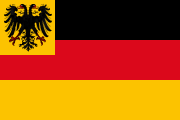
فض الاتحاد
صعود بسمارك
A new generation of statesmen responded to popular demands for national unity for their own ends, continuing Prussia's tradition of autocracy and reform from above. Germany found an able leader to accomplish the seemingly paradoxical task of conservative modernization. Bismarck was appointed by King Wilhelm I of Prussia (the future Kaiser Wilhelm I) to circumvent the liberals in the Landtag of Prussia, who resisted Wilhelm's autocratic militarism. Bismarck told the Diet, "The great questions of the day are not decided by speeches and majority votes ... but by blood and iron" — that is, by warfare and industrial might.[5] Prussia already had a great army; it was now augmented by rapid growth of economic power.
Gradually, Bismarck won over the middle class, reacting to the revolutionary sentiments expressed in 1848 by providing them with the economic opportunities for which the urban middle sectors had been fighting.[6]
حرب السبع أسابيع
The German Confederation ended as a result of the Austro-Prussian War of 1866 between Austrian Empire and its allies on one side and the Kingdom of Prussia and its allies on the other. In the Prague peace treaty, on 23 August 1866, Austria had to accept that the Confederation was dissolved.[7] The following day, the remaining member states confirmed the dissolution. The treaty allowed Prussia to create a new Bundesverhältnis (a new kind of federation) in the North of Germany. The South German states were allowed to create a South German Confederation but this did not come into existence.
الكونفدرالية الألمانية الشمالية
پروسيا أنشأت الكونفدرالية الألمانية الشمالية في 1867 لتشمل كل الدويلات الألمانية شمال نهر ماين وأيضاً أراضي هوهنتسولرن في سوابيا. بجانب النمسا، فقد بقيت الدويلات الألمانية الجنوبية باڤاريا و Württemberg, Baden, and Hesse-Darmstadt منفصلة عن باقي ألمانيا. However, due to the successful prosecution of the Franco-German War, the four southern states joined the North German Confederation by treaty in November 1870.[8]
الامبراطورية الألمانية
As the Franco-German War drew to a close, King Ludwig II of Bavaria was persuaded to ask King Wilhelm to assume the crown of the German Empire. On 1 January 1871, the Empire was declared by the presiding princes and generals in the Hall of Mirrors in the Palace of Versailles, near Paris. The Diet of the North German Confederation to rename the North German Confederation as the German Empire and give the title of German Emperor to the King of Prussia.[9] The new constitution of the state, the Constitution of the German Confederation, effectively transformed the Diet of the Confederation into the German Parliament (Reichstag).[10]
الذكرى الإقليمية
The current countries whose territory were partly or entirely located inside the boundaries of German Confederation 1815–1866 are:
- Germany (all states except Southern Schleswig in the north of Schleswig-Holstein)
- Austria (all states except Burgenland)
- Luxembourg (entire territory)
- Liechtenstein (entire territory)
- Netherlands (Duchy of Limburg, was a member of the Confederation from 1839 till 1866)
- Czech Republic (entire territory)
- Slovenia (except for Prekmurje and the municipalities of Koper, Izola and Piran)
- Poland (West Pomeranian Voivodship, Lubusz Voivodship, Lower Silesian Voivodship, Opole Voivodship, part of Silesia — overwhelmingly German speaking at the time; East Prussia, West Prussia, and much of the Grand Duchy of Posen were admitted into the Confederation on 11 April 1848,[11] but the terms of the restored Confederate Diet removed these territories on 30 May 1851)[12]
- Belgium (German-speaking community and some other territory in the east of the province of Liège); the larger province of Luxembourg had left the Confederation at its accession to Belgium in 1839
- Italy (autonomous region of Trentino-Alto Adige/Südtirol, the Province of Trieste, most of the Province of Gorizia except the Monfalcone enclave, and the municipalities of Tarvisio, Malborghetto Valbruna, Pontebba, Aquileia, Fiumicello, and Cervignano in the Province of Udine)
- Croatia (the Pazin territory in Istria county and the coastal strip between Opatija and Plomin in the Liburnia region)
- The Danish crown had been a member only in the context of its duchy of Holstein. Schleswig first joined on 12 April 1848 after a revolutionary government was formed in opposition to the new Danish Constitution.[13] The London Protocol of 1852 removed Schleswig from the Confederation, but the Second War of Schleswig returned the Duchy to the Confederation under Prussian governance as per the Treaty of Vienna in 1864.
انظر أيضاً
- States of the German Confederation
- History of Germany
- German Empire
- الكونفدرالية الألمانية الشمالية
- Former countries in Europe after 1815
- Federal Convention
- Frankfurt Parliament
الهامش
- ^ "German Confederation". Encyclopædia Britannica.
- ^ Deutsche Geschichte 1848/49, Meyers Konversationslexikon 1885–1892
- ^ Lee, Loyd E. (1985). "The German Confederation and the Consolidation of State Power in the South German States, 1815–1848". Consortium on Revolutionary Europe, 1750–1850: Proceedings. 15: 332–346. ISSN 0093-2574.
- ^ Murphy, David T. (1991). "Prussian aims for the Zollverein, 1828–1833". Historian. 53 (2): 285–302. doi:10.1111/j.1540-6563.1991.tb00808.x.
- ^ Martin Kitchen, A History of Modern Germany, 1800–2000 (2006) p. 105
- ^ Otto Pflanze, Bismarck and the Development of Germany, Vol. 1: The Period of Unification, 1815–1871 (1971)
- ^ Ernst Rudolf Huber: Deutsche Verfassungsgeschichte seit 1789. Vol. III: Bismarck und das Reich. 3rd edition, W. Kohlhammer, Stuttgart [u. a.] 1988, p. 571, 576.
- ^ Case, Nelson (1902). European Constitutional History. Cincinnati: Jennings & Pye. p. 139. OCLC 608806061.
{{cite book}}: Invalid|ref=harv(help) - ^ Case 1902, pp. 139–140
- ^ Ernst Rudolf Huber: Deutsche Verfassungsgeschichte seit 1789. Vol. III: Bismarck und das Reich. 3rd edition, W. Kohlhammer, Stuttgart [u. a.] 1988, p. 747.
- ^ Heinrich Sybel, The Founding of the German Empire by William I. 1890. Volume 1, page 182.
- ^ Charles Eugene Little, Cyclopedia of Classified Dates: With an Exhaustive Index, 1900, page 819.
- ^ Wilhelm Eichhoff, How Schleswig-Holstein has become what it is. Henry Gaskarth, 1864, page 18.
== المراجع ==* Westermann, Großer Atlas zur Weltgeschichte (in German, detailed maps)
- WorldStatesmen- here Germany; also links to a map on rootsweb.com
- Barrington Moore, Jr. 1993 [1966]. Social Origins of Dictatorship and Democracy. Boston: Beacon Press.
للاستزادة
- Blackbourn, David. The Long Nineteenth Century: A History of Germany, 1780–1918 (1998) excerpt and text search
- Blackbourn, David, and Geoff Eley. The Peculiarities of German History: Bourgeois Society and Politics in Nineteenth-Century Germany (1984) online edition
- Brose, Eric Dorn. German History, 1789–1871: From the Holy Roman Empire to the Bismarckian Reich. (1997) online edition
- Evans, Richard J., and W. R. Lee, eds. The German Peasantry: Conflict and Community from the Eighteenth to the Twentieth Centuries (1986)
- Nipperdey, Thomas. Germany from Napoleon to Bismarck (1996), very dense coverage of every aspect of German society, economy and government
- Pflanze, Otto. Bismarck and the Development of Germany, Vol. 1: The Period of Unification, 1815-1871 (1971)
- Ramm, Agatha. Germany, 1789–1919 (1967)
- Sagarra, Eda (1977). A Social History of Germany: 1648–1914. New York: Holmes & Meier. pp. 37–55, 183–202. ISBN 0841903328.
{{cite book}}: Invalid|ref=harv(help) - Sagarra, Eda. Introduction to Nineteenth Century Germany (1980)
- Sheehan, James J. German History, 1770–1866 (1993), 969pp; the major survey in English
- Werner, George S. Bavaria in the German Confederation 1820–1848 (1977)
50°06′29″N 8°40′30″E / 50.108°N 8.675°E
خطأ لوا في وحدة:Authority_control على السطر 278: attempt to call field '_showMessage' (a nil value).
- Pages using gadget WikiMiniAtlas
- Articles containing ألمانية-language text
- Pages using infobox country or infobox former country with the flag caption or type parameters
- Pages using infobox country or infobox former country with the symbol caption or type parameters
- Pages using Lang-xx templates
- Articles containing إنگليزية-language text
- Articles containing فرنسية-language text
- Articles containing Slovene-language text
- Articles containing إيطالية-language text
- Articles containing كرواتية-language text
- Pages with empty portal template
- Coordinates on Wikidata
- German Confederation
- History of Prussia
- Modern history of Austria
- Modern history of Germany
- Pan-Germanism
- 19th century in Germany
- 19th century in Prussia
- دول وأقاليم تأسست في 1815
- States and territories disestablished in 1848
- دول وأقاليم تأسست في 1850
- States and territories disestablished in 1866
- 1815 establishments in Europe
- 1815 establishments in the Austrian Empire
- 1815 establishments in Germany
- 1815 establishments in Prussia
- 1866 disestablishments in Europe
- 1860s disestablishments in the Austrian Empire
- 1866 disestablishments in Germany


